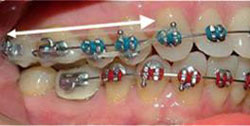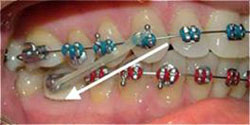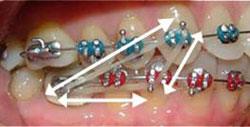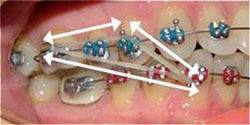Elastic Wear (Rubber Bands)
Orthodontic elastics, or rubber bands, are used along with braces to add extra force to the braces to enhance orthodontic tooth movements. The most difficult part of wearing elastics is getting accustomed to them. The energy that the elastics provide can also create some temporary discomfort, and wearing them properly helps this to pass quickly, often in less than a week. Below are some important fun facts about the rubber bands:
- Rubber bands are to be worn 24-hours per day, except when brushing your teeth or eating, unless stated otherwise by the orthodontist. Failure to wear your rubber bands, as instructed, can result in treatment running longer than expected. It may also affect the finished orthodontic treatment result.
- Change your rubber bands at least a few times per day with new rubber bands. Typically when you eat meals and brush your teeth. The rubber bands will eventually lose their elasticity.
- If you break or lose a rubber band, replace immediately. Always carry a spare pack of rubber bands in your pocket.
- Remember to replace your supply of rubber bands at every appointment.
If you are running low or lose your rubber bands, please contact the office and we would be more than happy to mail them to you. State the name of the animal on the packet to determine the size. All rubber bands have names of animals on the envelopes.
THE END RESULT, IN ORTHODONTIC TREATMENT, IS ONLY AS GOOD AS THE PATIENT THAT FOLLOWS INSTRUCTIONS!
Different Types of Rubber Band Wear
Class I Elastics
Closes spaces between teeth. Run elastic from upper 1st or 2nd molar hook to the upper cuspid hook. This elastic can be worn on lower arch also.
Class II Elastics
Retracts upper teeth and moves lower teeth forward, reducing overjet.
Class II Elastic
Run elastic from upper cuspid hook to the lower 1st or 2nd molar hook, as instructed.
Triangle Class II Elastic
Run the elastic from the upper cuspid to the lower 1st premolar and then to the lower 1st molar to form a triangle.
Class III Elastics
Retracts lower teeth and advances the upper teeth, reducing underbites.
Class III Elastic
Run elastic from the lower cuspid hook to the upper 1st or 2nd molar hook, as instructed.
Triangle Class III Elastic
Run the elastic from the lower cuspid to the upper 1st premolar and then to the upper 1st molar to form a triangle.
Vertical Elastics
Posterior box elastics
Closes a posterior openbite.
Anterior vertical elastics
Closes an anterior openbite







